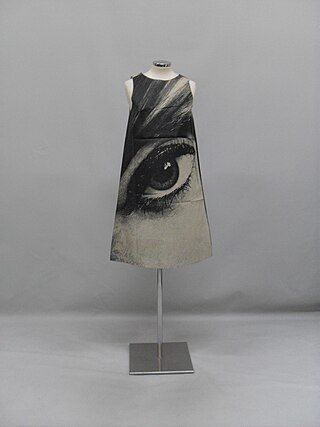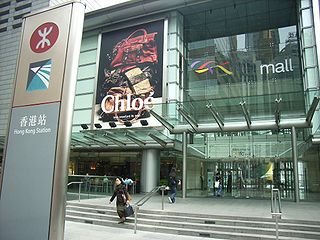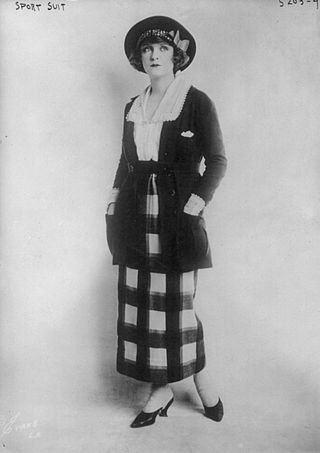Related Research Articles

Karl Otto Lagerfeld was a German fashion designer.

Dame Barbara Mary Quant was a British fashion designer and icon. She became an instrumental figure in the 1960s London-based Mod and youth fashion movements, and played a prominent role in London's Swinging Sixties culture. She was one of the designers who took credit for the miniskirt and hotpants. Ernestine Carter wrote: "It is given to a fortunate few to be born at the right time, in the right place, with the right talents. In recent fashion there are three: Chanel, Dior, and Mary Quant."
Pierre Cardin, born Pietro Costante Cardin, was an Italian-born naturalised-French fashion designer. He is known for what were his avant-garde style and Space Age designs. He preferred geometric shapes and motifs, often ignoring the female form. He advanced into unisex fashions, sometimes experimental, and not always practical. He founded his fashion house in 1950 and introduced the "bubble dress" in 1954.

Sir Norman Bishop Hartnell was a leading British fashion designer, best known for his work for the ladies of the royal family. Hartnell gained the Royal Warrant as Dressmaker to Queen Elizabeth in 1940, and Royal Warrant as Dressmaker to Queen Elizabeth II in 1957. Princess Beatrice also wore a dress designed for Queen Elizabeth II by Hartnell for her wedding in 2020.

Mod, from the word modernist, is a subculture that began in 1950s London and spread throughout Great Britain, eventually influencing fashions and trends in other countries. It continues today on a smaller scale. Focused on music and fashion, the subculture has its roots in a small group of stylish London-based young men and women in the late 1950s who were termed modernists because they listened to modern jazz. Elements of the mod subculture include fashion ; music and motor scooters. In the mid-1960s, the subculture listened to rock groups such as the Who and Small Faces. The original mod scene was associated with amphetamine-fuelled all-night jazz dancing at clubs.

Youthquake was a 1960s cultural movement. The term was coined by Vogue magazine's editor-in-chief Diana Vreeland in 1965. Youthquake involved music and pop culture, and it changed the landscape of the fashion industry. The movement is characterized by looking to youth culture for a source of inspiration, taking dominance away from the English and Parisian couture houses.

Chloé is a French luxury fashion house founded in 1952 by Gaby Aghion. During the next year of 1953 Aghion joined forces with Jacques Lenoir, formally managing the business side of the brand, allowing Aghion to purely pursue the creative growth of Chloé. Its headquarters are located in Paris. The house is owned by luxury brands holding company Richemont Group. Chloé has been worn by many celebrities, including Marion Cotillard, Sienna Miller, Madonna, January Jones, Maggie Gyllenhaal, Kirsten Dunst, Cameron Diaz, Emma Stone, Clémence Poésy and Katie Holmes. The brand is characterized by a youthful and bohemian aesthetic, and has produced several successful fragrances. As of October 2023, Chemena Kamali is its creative director.

Fashion of the 1980s was characterized by a rejection of 1970s fashion. Punk fashion began as a reaction against both the hippie movement of the past decades and the materialist values of the current decade. The first half of the decade was relatively tame in comparison to the second half, which was when apparel became very bright and vivid in appearance.

Fashion of the 1960s featured a number of diverse trends, as part of a decade that broke many fashion traditions, adopted new cultures, and launched a new age of social movements. Around the middle of the decade, fashions arising from small pockets of young people in a few urban centers received large amounts of media publicity, and began to heavily influence both the haute couture of elite designers and the mass-market manufacturers. Examples include the mini skirt, culottes, go-go boots, and more experimental fashions, less often seen on the street, such as curved PVC dresses and other PVC clothes.

Fashion in the 1970s was about individuality. In the early 1970s, Vogue proclaimed "There are no rules in the fashion game now" due to overproduction flooding the market with cheap synthetic clothing. Common items included mini skirts, bell-bottoms popularized by hippies, vintage clothing from the 1950s and earlier, and the androgynous glam rock and disco styles that introduced platform shoes, bright colors, glitter, and satin.

Norman David Levinson known professionally as Norman Norell, was an American fashion designer famed for his elegant gowns, suits, and tailored silhouettes. His designs for the Traina-Norell and Norell fashion houses became famous for their detailing, simple, timeless designs, and tailored construction. By the mid-twentieth century Norell dominated the American fashion industry and in 1968 he launched his own brand of perfume. The designer Gilbert Adrian was the first American designer to add a perfume line in 1945, with his "Saint" and "Sinner" fragrances.

History of fashion design refers specifically to the development of the purpose and intention behind garments, shoes, accessories, and their design and construction. The modern industry, based around firms or fashion houses run by individual designers, started in the 19th century with Charles Frederick Worth who, beginning in 1858, was the first designer to have his label sewn into the garments he created.
Michèle Rosier was a French fashion journalist and designer who founded the V de V sportswear label. In addition to this, she worked as a film director and screenwriter since 1973.

Sportswear is an American fashion term originally used to describe separates, but which since the 1930s has come to be applied to day and evening fashions of varying degrees of formality that demonstrate a specific relaxed approach to their design, while remaining appropriate for a wide range of social occasions. The term is not necessarily synonymous with activewear, clothing designed specifically for participants in sporting pursuits. Although sports clothing was available from European haute couture houses and "sporty" garments were increasingly worn as everyday or informal wear, the early American sportswear designers were associated with ready-to-wear manufacturers. While most fashions in America in the early 20th century were directly copied from, or influenced heavily by Paris, American sportswear became a home-grown exception to this rule, and could be described as the American Look. Sportswear was designed to be easy to look after, with accessible fastenings that enabled a modern emancipated woman to dress herself without a maid's assistance.

Anne Fogarty was an American fashion designer, active 1940–1980, who was noted for her understated, ladylike designs that were accessible to American women on a limited income. She started out as a model in New York in 1939, working for Harvey Berin on Seventh Avenue, before studying fashion design. She eventually secured a full-time design job in 1948, and became well-known for full-skirted designs with fitted bodices, inspired by Dior's New Look.
Rupert William Lycett Green is a British fashion designer known for his contribution to 1960s male fashion through his tailor's shop/boutique Blades in London.

Bianca Mosca, born Bianca Lea Rosa Mottironi, was a London-based fashion designer who rose to prominence during the 1940s and was the only woman member of the Incorporated Society of London Fashion Designers (IncSoc), which represented the interests of the British couture industry. In her heyday she was described as "one of the big 10 of the British fashion world", the others being Digby Morton, Norman Hartnell, Charles Creed, Molyneux, Worth, Mattli, Victor Stiebel, Hardy Amies, and Peter Russell. Her firm closed in 1949, a year before her death.
Martine Sitbon is a French fashion designer.
Judy Hornby, also known as Judith Hornby, is a British-born American-based former model, fashion designer and boutique owner. In 1971 one of her ensembles, designed for her by Graziella Fontana, was chosen as the Dress of the Year. She then went on to become a successful American fashion designer.
Kellie Wilson was an American model who worked in the 1960s and early 1970s.
References
- ↑ "Unknown title". Courier: Fact, Fiction, Art, Satire. 41. Norman Kark Publications Ltd. 1963.
- 1 2 Byrne, Julie (May 5, 1968). "MINI LOOK Mod Styles for Swinging Set". Los Angeles Times.(subscription required)
- ↑ "Chloe - Voguepedia". Vogue.com. Retrieved 22 January 2013.
- 1 2 Drake, Alicia (2012). The Beautiful Fall: Fashion, Genius and Glorious Excess in 1970s Paris. Bloomsbury Publishing. ISBN 9781408835944.
- ↑ Evans, Christopher Huw; Blanchard, Paul (1987). Gloria Bianchino (ed.). Italian fashion volume 2. Milano: Electa. ISBN 9780847808908.
- ↑ "Unknown title". Country Fair. 37. Norman Kark Publ. 1969.
The colours selected by Graziella Fontana, designer for Lyle & Scott, are excitingly different...
- ↑ "Dress of the Year 1970-1979". Fashion Museum, Bath. Archived from the original on 5 November 2013. Retrieved 22 January 2013.